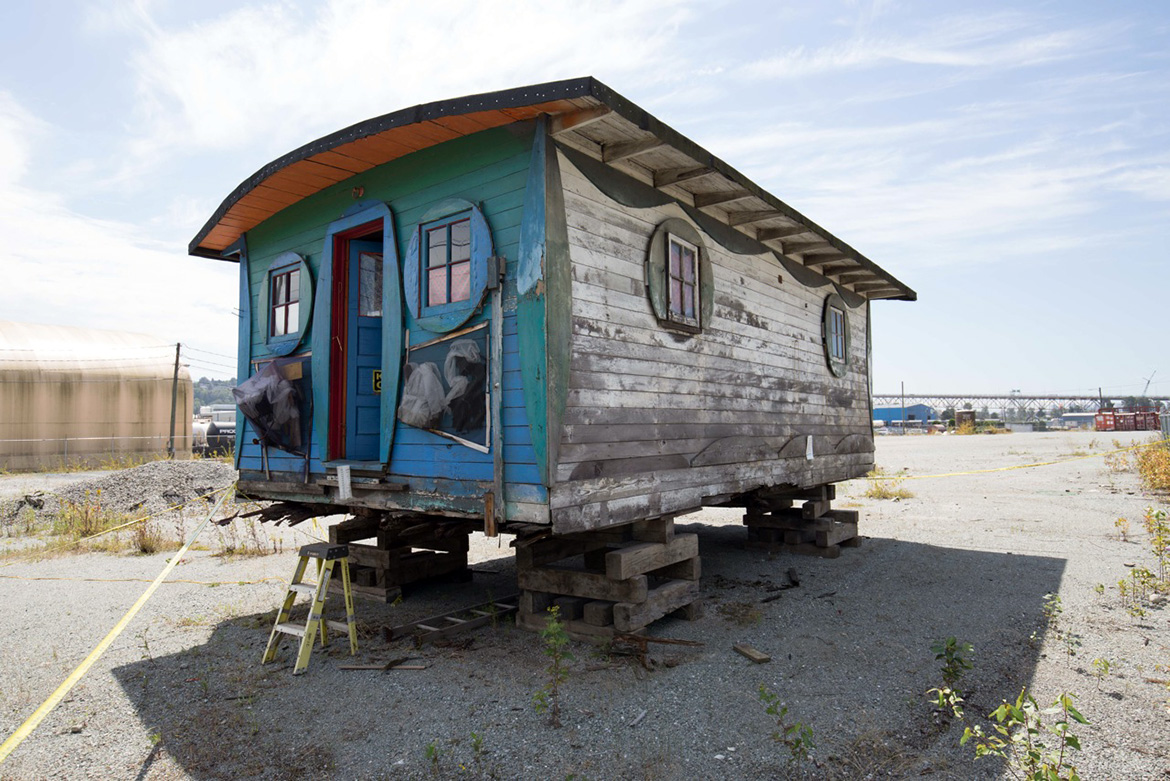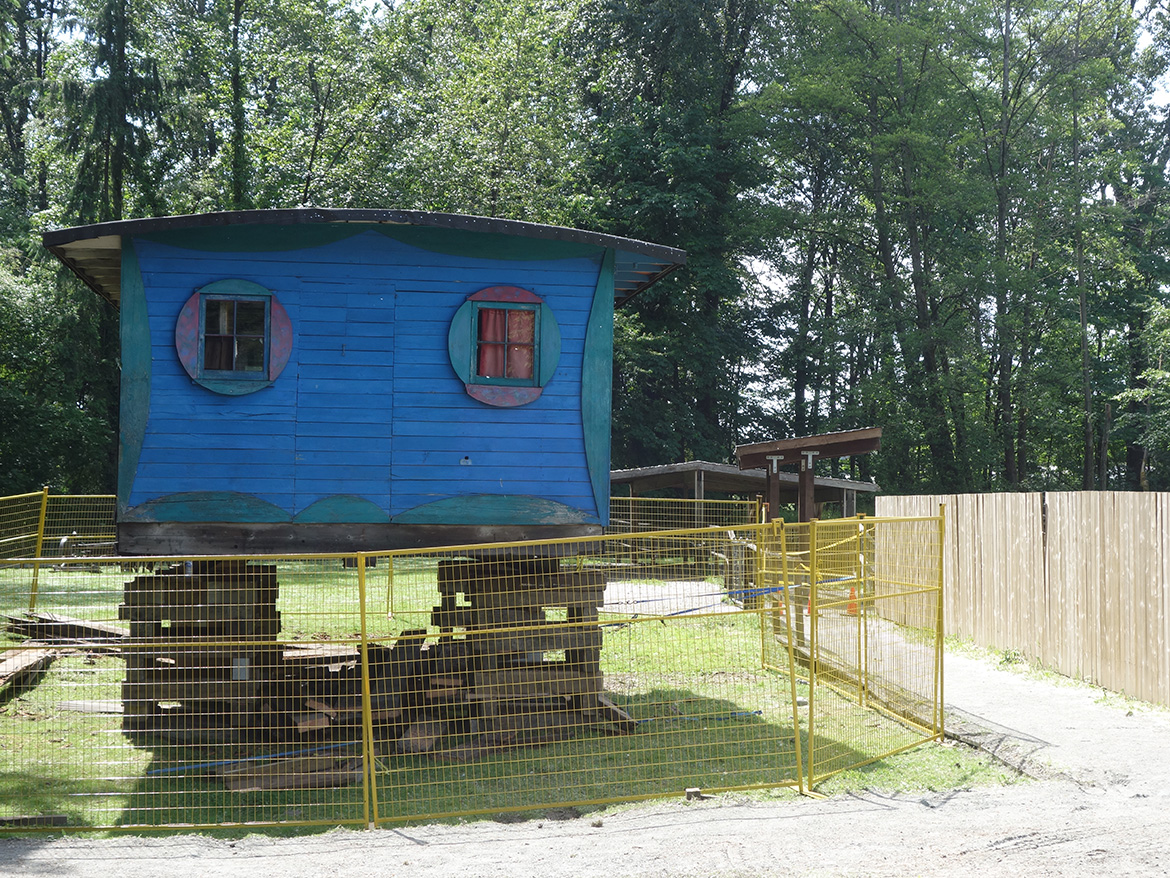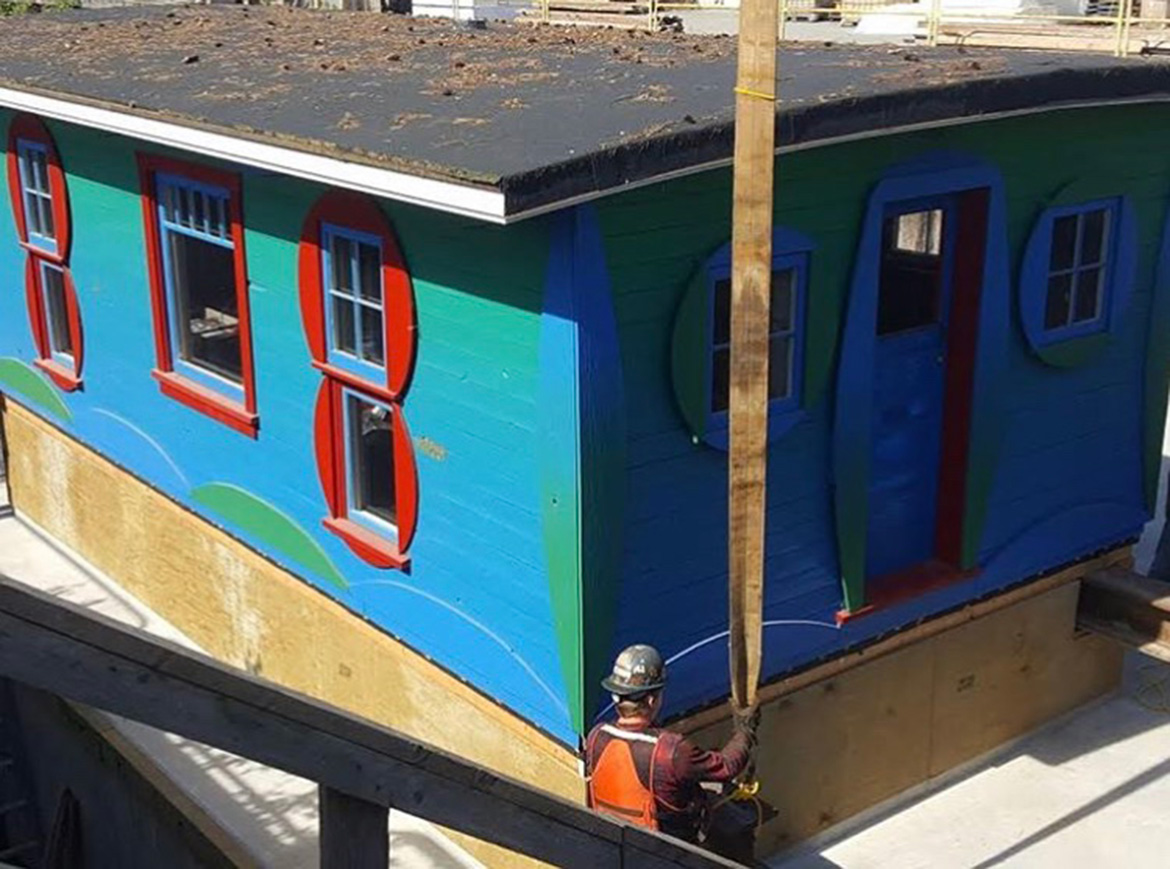The Blue Cabin Project
In early 2015, shortly after artists Al Neil and Carole Itter were served with a notice to vacate the Blue Cabin, grunt gallery’s Glenn Alteen, along with Esther Rausenberg of Creative Cultural Collaborations (C3) and Barbara Cole of Other Sights for Artists’ Projects, came together with an aim to save the cabin, and led efforts to move the structure to a protected, temporary storage site for repair and remediation. The District of North Vancouver helped to a secure lot at Canexus Corporation (now Chemtrade Electrochem Inc.) in North Vancouver, and the Blue Cabin remained there while plans for its future use were being worked out.

The Blue Cabin at Canexus Chemicals LP, 2015. Photo: Marko Simcic.
Polygon Homes, who had purchased the land adjacent to the cabin,1 built a wider road to move the cabin out of the cove and generously paid for its move, while Alteen, Rausenberg and Cole worked to develop a concept for an engagement site for the Blue Cabin. One key consideration was the lack of adequate spaces for extended stay residencies in Vancouver, largely due to continuously rising real estate prices. Taking this into account, and its history on the foreshore, the idea of repurposing the cabin as an off-the-grid floating artist residency on the Lower Mainland’s waterways emerged as the clear choice, one that would inspire curiosity, engagement, and exchange.
Cole writes, “The impetus to save the Blue Cabin began as a conversation amongst a number of artists and grew into a swell of support that travelled well beyond the reach of the Vancouver art community. United in their recognition of the cabin’s significance, people from all walks of life stepped up, wrote letters, and volunteered their time, expertise, and resources to ensure the 80-year-old squatters dwelling had a future, albeit one that was unknown. The cabin’s successful move was the result of collaborative effort, a gesture of cooperation that is now part of the ethos of the floating artist residency.”2
This overwhelming support helped to steadily advance the project, and by the spring of 2017, Alteen, Rausenberg and Cole had invited Mayne Island artists and builders Jeremy and Sus Borsos to assess the feasibility and scope of the restoration. The Borsos’, who later agreed to take on the extensive remediation, were known for their meta-historical approach in their use of salvaged architecture, and had constructed a number of dwellings and ancillary structures in Canada and in Europe.
The District of North Vancouver once again located and secured a site for the cabin, this time for its restoration, and on June 6, 2017, the cabin was trucked out of the Canexus lot and across Dollarton Highway to Maplewood Farm, where it was moved into a sheep pasture and lifted onto support cribbing.3 The setting was ideal, with goats and lambs as neighbours, and only a few days of rain that summer. Alteen describes the Borsos’ work as “part remediation and part archaeological dig.”4 Their remediation involved taking the cabin completely apart and rebuilding piece-by-piece with heritage materials. Simultaneously, the Borsos constructed a history of the cabin from the many pieces of newspaper stuffed between cracks, wasps and mouse nests, and pieces of the cabin itself. When they took up the floor, the Borsos discovered almost forty theatre, vaudeville, film, music, and boxing posters from 1927 that had been used to stop the floor from squeaking.5 The Borsos also documented each stage of the remediation in photographs and video.6 While the cabin was being restored at Maplewood, the Blue Cabin Committee worked on the research and design of the floating platform, and a sustainable deckhouse that would function as a home to resident artists.

The Blue Cabin at Maplewood Farm, 2017. Photo: Jeremy Borsos.
The Borsos’ wrapped up the remediation in the early months of 2018. In May 2019, the cabin was again lifted onto a flatbed truck and transferred to a dry dock in North Vancouver where it was secured onto an engineered floating platform.7 Award winning architect (Lieutenant Governor’s Award; Canadian Architect Award), artist, and Blue Cabin Committee member Marko Simcic worked on the design of the floating platform and the deckhouse in consultation with engineers and the Blue Cabin Committee. Artist Germaine Koh was brought in to develop the building systems. Koh has created works that look at creative space design, sustainability, and self-sufficiency as ways to address current housing issues relevant to the Lower Mainland. She managed the build of Blue Cabin’s deckhouse, constructed directly on the platform at Vancouver Pile Driver’s dry dock. The Blue Cabin Floating Artist Residency was placed into the waters of False Creek and launched as an artist residency in the summer of 2019. In January 2022, the Cabin was tugged up the Fraser River (Sto:lo) to Imperial Landing in Steveston Village.
Cole continues, “Offering artists the space and time to research, develop, and share their projects through live/work residencies are out of the reach of most ‘host’ organizations primarily due to the crisis of unaffordability plaguing the Metro Vancouver area. Despite being recognized as necessary to maintaining a healthy and vital art community, opportunities for dialogue and exchange with artists from places beyond the Pacific Northwest continue to decline. The Blue Cabin Committee saw the cabin’s return to the waterfront as an affordable way to counter this trend. While the ongoing gentrification of the Lower Mainland erases the city’s past, the cabin/studio and small dwelling aligns the history of squatting along Burrard Inlet with the present-day tiny house movement, both of which represent resourceful solutions to the challenges of finding affordable housing within a metropolitan area.

The Blue Cabin at Vancouver Pile Drivers, 2019. Photo: Krista Lomax.
As a collaborative effort that has captured the public’s imagination, the Blue Cabin Floating Artist Residency represents an innovative response to some of the most pressing issues of our time: global trade, the marine environment, sustainability, affordability, and the protection of culture and heritage.”8
With a commitment to keeping our histories alive through innovative and diverse programming, the Blue Cabin acts to sustain the memory of our city’s foreshores, places that are critical to Vancouver’s early development, and that hold its many histories, namely, maritime labour, trade, lumber, immigrant, squatter, Indigenous histories, and those of cultural production, all of which are important touchstones between residents and provide a heritage we can all share.
Artists Neil and Itter each greatly contributed to the cabin’s heritage value and cultural significance, and future resident artists will use the Blue Cabin as a site to imagine new and exciting ideas and create inspired projects that continue and expand upon that legacy.
- Polygon Homes had agreed to remediate the neighbouring contaminated foreshores, and this extended to the cove where the cabin was situated, so it had to be moved.
- Cole Projects, ‘Blue Cabin Floating Artist Residency Preliminary Feasibility Report’, Page 8, August 2016.
- See video of all the cabin’s moves on The Blue Cabin Vimeo page
- Glenn Alteen, The Blue Cabin Exhibition Catalogue, Page 4, June 2018.
- See Laurence Playford-Beaudet’s project Under the Floorboards at http://www.playford-beaudet.com/under-the-floorboards/ and video of Glenn Alteen and Perry Giguere on The Blue Cabin Vimeo page
- Read more about the remediation at https://thebluecabin.ca/the-blue-cabin-remediation/
- See video of all the cabin’s moves on The Blue Cabin Vimeo page.
- Ibid., Pages 8, 9